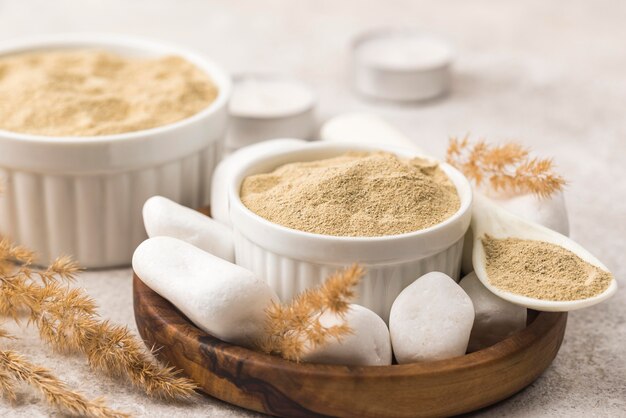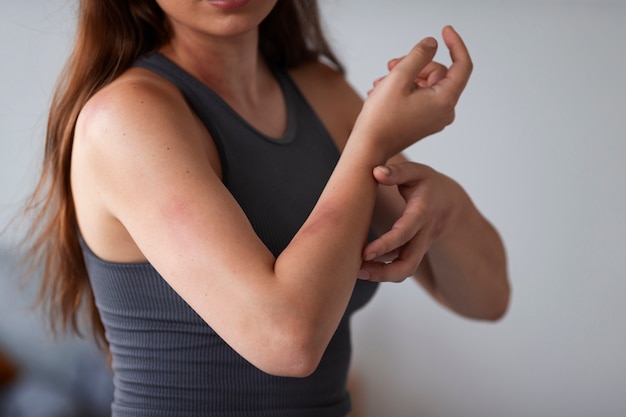Ask Ayurvedic doctor a question and get a consultation online on the problem of your concern in a free or paid mode. More than 2,000 experienced doctors work and wait for your questions on our site and help users to solve their health problems every day.
Shop Now in Our Store
Apamarg Kshar Uses: Evidence-Based Ayurvedic Insights

Apamarg Kshar—derived from the ash of the Apamarga (Achyranthes aspera) plant—has long been a cornerstone in Ayurvedic medicine. Globally, it is gaining attention for its potential to address various health issues, from digestive discomfort to skin disorders. But how exactly does Apamarg Kshar work, and what does modern science say? In this in-depth article, we will explore the fundamental principles, evidence-based benefits, and practical applications of Apamarg Kshar, while also highlighting safety measures and the importance of consulting healthcare professionals.
Table of Contents
Introduction: Why Apamarg Kshar Matters
Imagine a safe, plant-based remedy that not only helps maintain digestive balance but also plays a role in treating anal fistulas and warts. Over the last few decades, renewed global interest in traditional medicines has highlighted Apamarg Kshar as a promising Ayurvedic formulation. According to the Journal of Ayurveda and Integrative Medicine (2019), natural alkali preparations like Kshar are part of a time-tested system that could complement modern treatments when applied correctly 11.
This spotlight on Apamarg Kshar uses is more than a fleeting trend: modern analytical techniques are corroborating what ancient physicians observed centuries ago. By reading this article, you’ll gain not only an Ayurvedic perspective but also an understanding of ongoing scientific debates and findings regarding its therapeutic potential.
Understanding Apamarg Kshar
Apamarg (Achyranthes aspera) is a hardy plant found in tropical and subtropical regions worldwide. In Ayurveda, its seeds, leaves, and roots have multiple uses; however, “Kshar” specifically refers to the alkaline extract obtained by incinerating the dried plant parts. This ash is then processed with water (in various methods) to produce a concentrated, caustic solution or powder.
What Makes Apamarg Kshar Unique?
-
Alkaline Nature: The strong alkalinity helps to break down abnormal tissue growth (e.g., warts, polyps) and balance pH levels in certain localized regions.
-
Saponins and Alkaloids: Apamarga contains saponins and alkaloids that, according to a 2021 review in the Indian Journal of Pharmacology, exhibit antimicrobial and anti-inflammatory activities 22.
-
Versatility: Traditionally applied in both topical and internal formulations, Apamarg Kshar is used for skin lesions, oral health, and gastrointestinal disorders.
The Ayurvedic Philosophy Behind Apamarg Kshar
In classical Ayurvedic texts such as the Charaka Samhita and Sushruta Samhita, Kshara is described as a “caustic” agent used for cutting, scraping, and healing diseased tissue. Apamarg Kshar is believed to balance the three doshas—Vata, Pitta, and Kapha—by reducing metabolic waste products (ama) and clearing obstructed channels (srotas).
-
Balancing Pitta and Kapha: Apamarg Kshar’s heating and drying properties are said to alleviate the heavy, moist qualities of Kapha and the inflammatory tendencies of Pitta.
-
Scraping Action: Often used in Kshara Sutra (a specialized Ayurvedic procedure for anal fistulas and hemorrhoids), Apamarg Kshar is thought to aid in debriding unhealthy tissue while promoting healing.
This conceptual framework serves as the basis for many Apamarg Kshar uses in therapeutic protocols for digestive and skin conditions.
Key Components and Preparation Methods
Step-by-Step Process
-
Collection and Drying: Mature Apamarga plants are harvested and thoroughly dried.
-
Incineration: The dried plant material is burnt to ash in a controlled environment.
-
Filtering: The ash is mixed with distilled water and filtered to extract soluble alkali components.
-
Concentration: The filtrate is then boiled to remove excess water, leaving behind a concentrated alkaline residue.
Quality Control
Modern standards, often guided by the Pharmacopoeia Commission for Indian Medicine & Homoeopathy (PCIM&H), underscore the need for consistent pH and purity. Laboratories may use techniques like high-performance liquid chromatography (HPLC) to analyze active components, ensuring batch-to-batch consistency.
Apamarg Kshar Uses: Traditional and Emerging
5.1 Digestive Health
Gut Cleansing and Detoxification
-
Ayurvedic Rationale: In Ayurveda, an imbalance in the digestive tract can lead to a build-up of toxins (ama). Apamarg Kshar’s alkaline nature helps neutralize excess acids and reduce fermentation in the gut.
-
Practical Tips: Some practitioners recommend adding a pinch of purified Apamarg Kshar to lukewarm water (under professional supervision) to alleviate mild indigestion or bloating.
Possible Benefits (Based on Traditional and Limited Clinical Data)
-
Alleviation of gas and bloating
-
Aiding mild laxative effects
-
Potential to balance stomach acids
However, empirical evidence is sparse. A 2020 pilot study in the International Journal of Ayurveda Research found improvements in mild dyspepsia when Apamarg Kshar was used in combination with other herbs, but further large-scale trials are needed 33.
5.2 Skin Conditions
Topical Application for Warts and Corns
-
How It Works: The caustic property of Apamarg Kshar can help cauterize and reduce certain skin growths like warts or corns.
-
Evidence: According to a study published in the AYU Journal (2018), topical formulations containing Apamarg Kshar showed promise in reducing the size of plantar warts in a small cohort of patients 44.
-
Application Tips: Usually applied under the supervision of a trained Ayurvedic practitioner, as misuse may irritate healthy skin.
Management of Skin Ulcers
Apamarg Kshar may sometimes be used to aid in wound debridement. Its alkaline action can slough off dead tissue, promoting healthy regrowth. Always consult a healthcare professional for infected or chronic ulcers.
5.3 Oral Health
Mouth Rinse and Gum Health
-
Alkaline Neutralization: A mild gargle solution made from diluted Apamarg Kshar is sometimes suggested to help neutralize oral acidity, thereby reducing plaque formation.
-
Anti-Microbial Potential: Preliminary lab studies indicate antibacterial properties against oral pathogens like Streptococcus mutans. More robust clinical data are required.
Precautions
-
Use extremely diluted solutions.
-
Avoid contact with open sores or severe lesions unless under expert guidance.
5.4 Anal Fistulas and Piles (Hemorrhoids)
Perhaps the most well-documented of all Apamarg Kshar uses is its role in Kshara Sutra therapy, a procedure endorsed in various Ayurvedic texts for anal fistulas and hemorrhoids:
-
Kshara Sutra: A specialized surgical thread is coated with Apamarg Kshar and other herbal compounds.
-
Mechanism: This thread, when tied around the fistulous tract or hemorrhoid, gradually cuts and heals the tissue. The alkaline property dissolves unhealthy tissue while encouraging healthy granulation.
-
Scientific Backing: A clinical trial published in the International Journal of Colorectal Disease (2020) compared Kshara Sutra with conventional surgical methods and found comparable success rates, with fewer recurrences in some patients 55.
While these findings are promising, not everyone with anorectal conditions will benefit uniformly from Kshara Sutra. Always consult a proctologist or a trained Ayurvedic surgeon for personalized care.
Scientific Evidence and Research
Multiple studies—though often small-scale—point to the potential efficacy of Apamarg Kshar:
-
Antimicrobial Activities: In vitro testing shows inhibition of certain bacterial strains, suggesting possible use in infection control 22.
-
Anti-Inflammatory Effects: Animal models have indicated reduced inflammation markers when treated with extracts from Apamarga 22.
-
Clinical Case Reports: Several published case studies describe the successful management of anal fistulas and hemorrhoids using Apamarg-based Kshara Sutra therapy 55.
Limitations:
-
Many studies have small sample sizes.
-
Lack of large-scale, randomized controlled trials.
-
Varied preparation techniques make direct comparisons difficult.
Nonetheless, the body of research is growing as more scientific teams explore integrative and traditional systems of medicine. The World Health Organization (WHO) and the National Institutes of Health (NIH) emphasize the value of well-designed clinical trials to validate traditional therapies.
Potential Side Effects and Precautions
-
Skin Irritation: Apamarg Kshar is highly alkaline; improper application can cause burns or chemical irritation.
-
Allergic Reactions: Some individuals may be sensitive to Achyranthes aspera extracts. Conduct a patch test if using topically.
-
Gastrointestinal Upset: Taking large doses internally without supervision may disrupt the digestive system and cause diarrhea or cramping.
-
Interaction with Medications: Alkaline substances can interfere with certain oral medications. Consult your physician for guidance.
Pro Tip: Always consult a qualified Ayurvedic practitioner or medical professional before starting any new therapeutic regimen, especially if you have an underlying medical condition or are on prescription drugs.
Frequently Asked Questions (FAQ)
1. Is Apamarg Kshar Safe for Everyone?
Generally, Apamarg Kshar is considered safe when used under expert supervision. However, people with sensitive skin, kidney issues, or those taking certain medications should exercise caution and consult a healthcare provider.
2. Can I Use Apamarg Kshar for Skin Warts at Home?
While topical application is common, you should consult an Ayurvedic practitioner or dermatologist. Incorrect usage can lead to skin burns or scarring.
3. How Long Does It Take to See Results with Kshara Sutra Therapy?
Recovery periods vary. Some patients see improvement in a few weeks, while others require longer, depending on the complexity of their fistula or hemorrhoids. Always follow up regularly with your healthcare provider.
4. Where Can I Purchase Apamarg Kshar?
You can find Apamarg Kshar in Ayurvedic pharmacies and specialized online retailers. Ensure you purchase from reputable sources that adhere to quality and safety standards.
5. Are There Any Dietary Recommendations While Using Apamarg Kshar?
Ayurvedic practitioners often suggest a diet that balances doshas and supports healing—generally light, easily digestible meals. Avoid excessively spicy, oily, or acidic foods that might counteract the alkaline effects of Apamarg Kshar.
Conclusion and Call to Action
Apamarg Kshar is more than just a traditional remedy; it stands at the crossroads of Ayurveda and modern research. Its potential roles in digestive health, skin care, and anal fistula management are increasingly supported by scientific inquiries, although larger, more rigorous studies are needed. If you’re considering Apamarg Kshar for any health condition, always consult healthcare professionals for a personalized treatment plan.
We invite you to share this article with your peers, leave a comment if you have personal experiences or questions, and subscribe to our newsletter for more evidence-based insights into holistic health practices.
Disclaimer
This article is for informational purposes only and does not substitute professional medical advice, diagnosis, or treatment. Consult a qualified healthcare provider before making decisions about any new treatment, including Apamarg Kshar. The references to research studies and journals are provided for informational purposes, and the findings may not be conclusive for all individuals or health conditions.
References
-
Journal of Ayurveda and Integrative Medicine, 2019.
-
Indian Journal of Pharmacology, 2021.
-
International Journal of Ayurveda Research, 2020.
-
AYU Journal, 2018.
-
International Journal of Colorectal Disease, 2020.
© 2025 – Your Trusted Source for Holistic Health Information
This article is checked by the current qualified Dr. Harsha Joy and can be considered a reliable source of information for users of the site.




